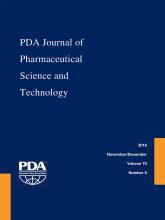Abstract
Sterility testing as described in the European Pharmacopoeia Chapter 2.6.1 as well as the United States Pharmacopeia Chapter 71 requires a 14 day incubation period of the test product in two different media and at two different temperatures. Because of extensive personnel requirements for test performance and quality assurance, alternative and partially automated methods for product sterility testing are of interest. The study objective was to evaluate the applicability of the BacT/ALERT® 3D™ Dual T system (Biomérieux, Nürtingen, Germany) for detection of microbial contaminants according to current pharmacopoeia standards. In addition, we compared the BacT/ALERT® 3D™ Dual T system to conventional pharmacopoeia sterility testing using the direct inoculation method. The results showed no significant disadvantages of sterility testing by BacT/ALERT® 3D™ Dual T compared to the direct inoculation method regarding the ability to detect microbial contamination. Furthermore, product testing using the BacT/ALERT® 3D™ Dual T system met the compendia requirements for method qualification. Altogether, our data provide evidence that the BacT/ALERT® 3D™ Dual T system is a promising alternative for sterility testing of injectable products of sample volume below 10 mL and without antimicrobial activity.
LAY ABSTRACT: Sterility is defined as the freedom from the presence of viable microorganisms. Injectable pharmaceutical products that are sometimes used for treatment of patients need to be free of microorganisms and therefore tested in the laboratory to confirm sterility. The testing procedures are described in detail in the European Pharmacopoeia. To test for sterility, the products need to be incubated for 14 days at two different temperatures and using two different growth media to ensure growth of various microorganisms. These tests, however, are cost- and labor-intensive. Therefore, we sought to use an automated system to reduce costs and hands-on time, as well as to improve quality assurance. The study objective was to evaluate the applicability of the automated BacT/ALERT® 3D™ Dual T system (Biomérieux, Nürtingen, Germany) for detection of microorganisms according to current pharmacopeia standards. We compared the BacT/ALERT® 3D™ Dual T system to standard sterility testing using the so-called direct inoculation method. The results showed no major disadvantages of sterility testing by the automated system compared to the standard method with regard to the detection level of microorganisms. Furthermore, product testing using the BacT/ALERT® 3D™ Dual T system met the compendia requirements for method qualification. Additionally, the new automated method provided reliable results and promises a higher robustness to human errors than do standard manual methods, which might reduce the potential for errors and improves quality assurance. Altogether, our data provide evidence that the BacT/ALERT® 3D™ Dual T system is a promising alternative for sterility testing of injectable products.
- © PDA, Inc. 2016
PDA members receive access to all articles published in the current year and previous volume year. Institutional subscribers received access to all content. Log in below to receive access to this article if you are either of these.
If you are neither or you are a PDA member trying to access an article outside of your membership license, then you must purchase access to this article (below). If you do not have a username or password for JPST, you will be required to create an account prior to purchasing.
Full issue PDFs are for PDA members only.
Note to pda.org users
The PDA and PDA bookstore websites (www.pda.org and www.pda.org/bookstore) are separate websites from the PDA JPST website. When you first join PDA, your initial UserID and Password are sent to HighWirePress to create your PDA JPST account. Subsequent UserrID and Password changes required at the PDA websites will not pass on to PDA JPST and vice versa. If you forget your PDA JPST UserID and/or Password, you can request help to retrieve UserID and reset Password below.






